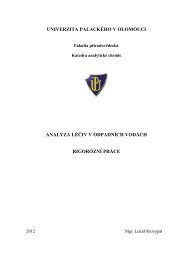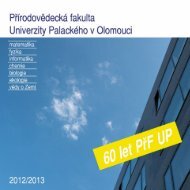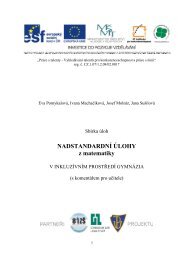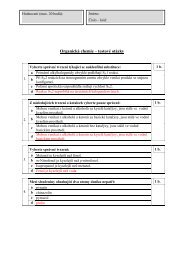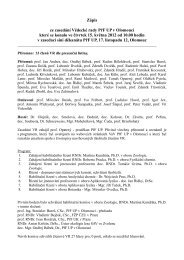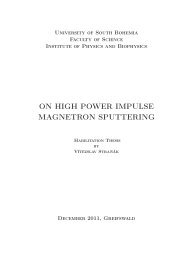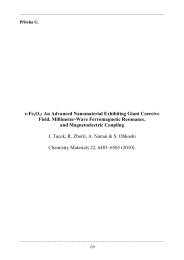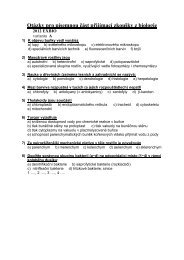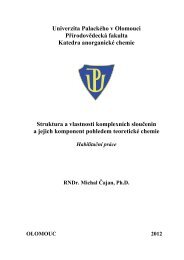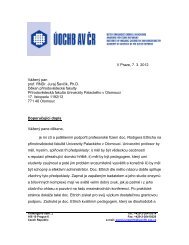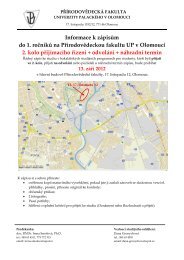A comparative structural analysis of direct and indirect shoot ...
A comparative structural analysis of direct and indirect shoot ...
A comparative structural analysis of direct and indirect shoot ...
Create successful ePaper yourself
Turn your PDF publications into a flip-book with our unique Google optimized e-Paper software.
J. Samaj et al. / Cell Biology International 27 (2003) 257–259 259<br />
actin stabilization with jasplakinolide, an inducer <strong>of</strong><br />
actin polymerization, SIMK co-localized with thick<br />
actin cables in the cytoplasm. Importantly, latrunculin B<br />
<strong>and</strong> jasplakinolide were both found to activate SIMK in<br />
a root-derived cell culture (Samaj et al., 2002). Loss <strong>of</strong><br />
tip-focused SIMK <strong>and</strong> actin was induced by the MAPK<br />
kinase inhibitor UO 126 <strong>and</strong> resulted in aberrant root<br />
hairs. UO 126 inhibits polarized root hair growth by<br />
changing polar vesicle trafficking <strong>and</strong> root hair cytoarchitecture.<br />
After UO 126 treatment, arrest <strong>of</strong> hair<br />
growth <strong>and</strong> vacuolation <strong>of</strong> root hair tips were observed<br />
by video enhanced microscopy. Tubular small vacuoles<br />
within the tip inflated to large roundish vacuoles that<br />
oscillated in r<strong>and</strong>om motion, <strong>and</strong> the shape <strong>of</strong> the apical<br />
dome became swollen. SIMK was distributed evenly in<br />
cytoplasm <strong>and</strong> nuclei <strong>of</strong> UO 126 treated hairs without<br />
any preferable accumulation in subcellular compartments<br />
(Samaj et al., 2002). Thus, UO 126 inhibits root<br />
hair tip growth by modifying the cytoarchitecture <strong>and</strong><br />
actin-dependent polar vesicle targeting <strong>and</strong> trafficking.<br />
In contrast to SIMK inhibition, overexpression <strong>of</strong> gain<strong>of</strong>-function<br />
SIMK induced rapid tip-growth <strong>of</strong> root<br />
hairs <strong>and</strong> could bypass growth inhibition by UO 126.<br />
3. Conclusions<br />
An intact actin cytoskeleton <strong>and</strong> vesicle trafficking<br />
are necessary for the proper localization <strong>of</strong> SIMK within<br />
root hair tips. Depolymerization <strong>and</strong> stabilization <strong>of</strong><br />
F-actin activate SIMK, indicating that the MAPK is not<br />
only associated with the actin cytoskeleton but its<br />
activity is also <strong>direct</strong>ly affected by altering the dynamics<br />
<strong>of</strong> F-actin. Inhibition <strong>of</strong> MAPK activity caused remodeling<br />
<strong>and</strong> changes in the subcellular distribution <strong>of</strong><br />
actin <strong>and</strong> SIMK, resulting in tip-growth inhibition <strong>and</strong><br />
aberrant root hair morphology. On the other h<strong>and</strong>,<br />
overexpression <strong>of</strong> gain-<strong>of</strong>-function SIMK in transgenic<br />
plants resulted in increased root hair formation <strong>and</strong><br />
growth. Taken together, our data suggest that SIMK<br />
plays an important role in root hair tip growth linking<br />
MAPK signaling to actin cytoskeleton.<br />
References<br />
Baluška F, Volkmann D. Actin-driven polar growth <strong>of</strong> plant cells.<br />
Trends Cell Biol 2002;12:14.<br />
Baluška F, Salaj J, Mathur J, Braun M, Jasper F, Šamaj J et al. Root<br />
hair formation: F-actin-dependent tip growth is initiated by local<br />
assembly <strong>of</strong> pr<strong>of</strong>ilin-supported F-actin meshworks accumulated<br />
within expansin-enriched bulges. Dev Biol 2000;227:618–32.<br />
Baluška F, Ovecka M, Hirt H. Salt stress- <strong>and</strong> cell cycle phasedependent<br />
changes in expression <strong>and</strong> subcellular localisation <strong>of</strong> the<br />
alfalfa mitogen-activated protein kinase SIMK. Protoplasma 2000;<br />
212:262–7.<br />
Braun M, Baluška F, Von Witsch M, Menzel D. Redistribution <strong>of</strong><br />
actin, pr<strong>of</strong>ilin <strong>and</strong> phosphatidylinositol-4,5-bisphosphate (PIP 2 )in<br />
growing <strong>and</strong> maturing root hairs. Planta 1999;209:435–43.<br />
Cardinale F, Jonak C, Ligterink W, Niehaus K, Boller T, Hirt H.<br />
Differential activation <strong>of</strong> four specific MAPK pathways by distinct<br />
elicitors. J Biol Chem 2000;275:36734–40.<br />
Kiegerl S, Cardinale F, Siligan C, Gross A, Baudouin E, Liwosz A<br />
et al. SIMKK, a mitogen-activated protein kinase (MAPK)<br />
kinase, is a specific activator <strong>of</strong> the salt stress-induced MAPK,<br />
SIMK. Plant Cell 2000;12:2247–58.<br />
Miller DD, De Ruijter NCA, Bisseling T, Emons AMC. The role<br />
<strong>of</strong> actin in root hair morphogenesis: studies with lipochitooligosaccharide<br />
as a growth stimulator <strong>and</strong> cytochalasin as an actin<br />
perturbing drug. Plant J 1999;17:141–54.<br />
Munnik T, Ligterink W, Meskiene I, Calderini O, Beyerly J, Musgrave<br />
A et al. Distinct osmosensing protein kinase pathways are involved<br />
in signaling moderate <strong>and</strong> severe hyperosmotic stress. Plant J 1999;<br />
20:381–8.<br />
Samaj J, Ovecka M, Hlavacka A, Lecourieux F, Meskiene I,<br />
Lichtscheidl I et al. Involvement <strong>of</strong> the mitogen-activated protein<br />
kinase SIMK in regulation <strong>of</strong> root hair tip-growth. EMBO J 2002;<br />
21:3296–306.




